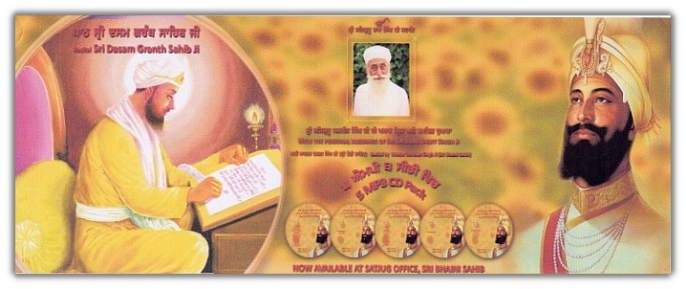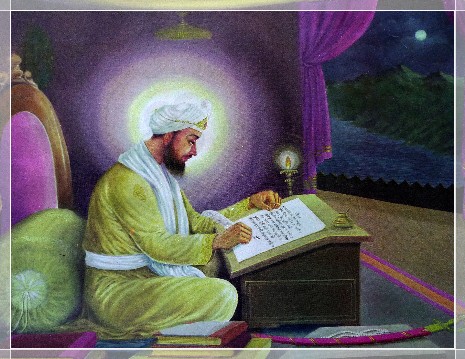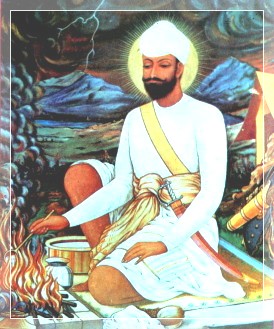namdhari world
Main menu:
- Home Page
- Kuka Faith
- History
- Sikh Gurus
- Namdhari Gurus
- Freedom Fighter - Satguru Ram Singh Ji
- Warrior of Peace
- Non-Cooperation Movement page 1
- Non-Cooperation Movment page 2
- Kuka Postal Service
- No Trial
- Battle for recognition as part of India's struggle for freedom
- Plaque at Ludhiana Railway Station
- Ram Singh Kuka by G.K.Venkateshamurthy
- Social Reforms by Satguru Ram Singh Ji
- Birth of Sant Khalsa
- Kuka Movement - by Film division of Government of India
- KUKA LEHAR - India's first war for independance (1856)
- Satguru Jagjit Singh Ji
- Contradictions
- Historical Quotes
- Vaisakhi - 1699
- Gurmukhi Script
- Sikh Women
- Knowlegde Bank
- Connections
- Places to visit
- Resources
- Music World
- Calendar
- Sports
- ETC...
Dhasam Granth Sahib
Kuka Faith

The Shri Dasam Granth Sahib contains 1428 pages and is the collection of writings of the Tenth Guru, Sri Guru Gobind Singh Ji.
It contains:
- Jaap Sahib.
- The Akal Ustat or praise of the Creator.
- The Bachitar Natak or Wonderful Drama, in which he gives an account of his parentage, his divine mission, and the battles in which he had been engaged.
- Then come three abridged compositions of the wars of Durga with demons, (Chandi Charitar(s): Chandi Charitar I, Chandi Charitar II, Chandi Di Var). These were written to instill the spirit of bravery among Sikhs. The first stanza of the Sikh Ardaas is from Chandi Di Var.
- Then follow the Gyan Parbodh or awakening of knowledge.
- Chobis Avatar accounts of twenty-four incarnations of the Vishnu, according to the Hindus, followed by Brahma Avatar and Rudar Avtar (Datta Trai and Parasnath), both selected because of their warlike character.
- The Shabad Hazare.
- Quatrains called Sawaiyas, which are religious hymns in praise of God and reprobation of idolatry and hypocrisy.
- The Khalsa Mahima, or words in praise of the Khalsa.
- The Shastar Nam Mala, a list of weapons used in the Guru's time, with special reference to the attributes of the Creator
- The Tria Charitar, or tales illustrating the qualities, but principally the deceit of women;
- The Kabiovach Bainti. Chaupai will "absolve the suffering, pain or fear of the person, who will recite this Bani even once "
- The Zafarnama,containing the Guru's epistle to the emperor Aurangzeb.
- Hikayats, several metrical tales in the Persian language.
- To this we must add 8 pages of Asfotak Chhand and 4 pages of Ugardanti.
PURPOSE OF THE DASAM GRANTH
Created with the aim of waging a war of righteousness, the Dasam Granth is a unique and unforgettable offering to the Indian culture, which changed the very face of religion, society, in fact the very nation. Guru Gobind Singh Ji made an appearance at that crucial point of Indian history when the glory of India had been debased by the bestial cruelties of foreign rulers and its own internal disputes. India, as one country, existed in name only.
Sri Guru Nanak Dev Ji had refuted and refused to accept all a-dynamic, parochial, and inhuman religious practices. In place of these he encouraged religious practices that upheld the universal good and well being. In order to preach and promote this reformation, he did not hesitate in sacrificing all he had. Sri Guru Arjun Dev Ji and Sri Guru Tegh Bahadur Ji started the tradition of offering their very lives.
Finally. Sri Guru Gobind Singh ji gave manifestation to his goal for the well being of all humanity in the form of a religious war of righteousness which aimed at destroying the inhuman and cruel administrative system of times. It is through this great achievement that Guru Gobind Singh Ji emerges as one of the greatest Karam Yogis in the chronicles of mankind.
Guru Gobind Singh Ji was a magnanimous soul. His vision, creation (of the Khalsa) and "His literary work has a common link that binds them together. He gave expression to the doctrinal ideology of Gurmat through his writings and as a further elaboration and extension of this ideology started a war for the freedom and upliftment of society. Thus devoting him completely through mind, discourse and deeds.
Guru Ji totally transformed the very - face of society. With a view to create a society free from exploitation and tyranny. He spelt out his aim "Dharam yudh ko chao" (Aspiration for a war of righteousness) in the form of a literary masterpiece.
The complete literary work of Guru Gobind Singh Ji is compiled in the Dasam Granth. These were put together in the present form by Bhai Mani Singh and some other leading sikhs who were always present in the Darbar (court) of the Guru and had complete knowledge of his writings. Although the manuscripts of these writings were lost in the river Sirsa, hand written copies of all these important works were collected and compiled in the form of the Dasam Granth.
A Punjabi historian of the last century explains the Guru's purpose as follows "The Guru discovered that the Sikhs had become feeblehearted. Therefore (said the Guru), I myself will prepare such a Granth that the Sikhs by just reading it will leam the art of ruling, the use of weapons, and other skills so that they will become fit for warfare; so from that very day he began the compositions of a huge volume, and when it was completed on Sunday, on the eighth day of the new moon in the month of Bhadon 1753 Bikrami (1696) he named it "The Granth of the Tenth Sovereign."
At the end of the Krishan Avtar, the following stanza of the Guru is written (verse 2491): "I have rendered in the vernacular the tenth chapter of the Bhagavat with no other purpose than to arouse desire for a holy war (a righteous war of the Lord)"
This militant purpose should not say that the Guru was a vengeful militarist. His wars were wars of defense; and his own poetry as well as his conduct shows a longing for peace and harmonious fellowship, which sometimes extended even to his former enemies.
Gyani Gyan Singh has given in his Panth Parkash recognition to four Birs. These four Birs are:
1. First, the one associated with the name of Bhai Mani Singh;
2. Second, at present in the Gurdwara Moti Bagh, Patiala;
3. Third, in the Dewan, Khana, Sangrur;
4. Fourth, in Gurdwara Janam Asthan, Patna.
(Article by Kirpal S Chana)

